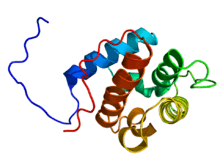
Calponin
Calponin is a calcium binding protein. Calponin tonically inhibits the ATPase activity of myosin in smooth muscle. Phosphorylation of calponin by a protein kinase, which is dependent upon calcium binding to calmodulin, releases the calponin's inhibition of the smooth muscle ATPase.
Structure and function
Calponin is mainly made up of α-helices with hydrogen bond turns. It is a binding protein and is made up of three domains. These domains in order of appearance are Calponin Homology (CH), regulatory domain (RD), and Click-23, domain that contains the calponin repeats. At the CH domain calponin binds to α-actin and filamin and binds to actin within the RD domain. Calmodulin, when activated by calcium may bind weakly to the CH domain and inhibit calponin binding with α-actin. Calponin is responsible for binding many actin binding proteins, phospholipids, and regulates the actin/myosin interaction. Calponin is also thought to negatively affect the bone making process due to being expressed in high amounts in osteoblasts.

Calponin 1
Calponin 1 is a basic smooth muscle protein that in humans is encoded by the CNN1 gene.
The CNN1 gene is located at 19p13.2-p13.1 in the human chromosomal genome and contains 7 exons, encoding the protein calponin 1, an actin filament-associated regulatory protein. Human calponin 1 is a 33.2-KDa protein consists of 297 amino acids with an isoelectric point of 9.1, thus calponin 1 is also known as basic calponin.
Evolution
Three homologous genes, Cnn1, Cnn2 and Cnn3, have evolved in vertebrates, encoding three isoforms of calponin: calponin 1, calponin 2, calponin 3, respectively. Protein sequence alignment shows that calponin 1 is highly conserved in mammals but more diverged among lower vertebrates.
Smooth muscle-specific expression
The expression of CNN1 is specific to differentiated mature smooth muscle cells, suggesting a role in contractile functions. Calponin 1 is up-regulated in smooth muscle tissues during postnatal development with a higher content in phasic smooth muscle of the digestive tract.

Calponin 2
Calponin 2 is a protein that in humans is encoded by the CNN2 gene.
The CNN2 gene is located at 19p13.3 in the human chromosomal genome, encoding the protein calponin 2. Calponin 2 is one of the three isoforms of calponin and an actin filament-associated regulatory protein with wide tissue distributions. Human calponin 2 is a 33.7-kDa protein consisting of 309 amino acids with an isoelectric point (pI) of 7.23. Accordingly, it is also known as neutral calponin.
Evolution
Calponin isoforms are conserved proteins whereas calponin 2 has diverged from calponin 1 and calponin 3 mainly in the C-terminal variable region. Phylogenetic lineage of calponin 2 showed that calponin 2 is conserved among mammalian species but more diverged among amphibian, reptile and fish species (Fig 1).
Tissue distribution
CNN2 is expressed in a broader range of tissue and cell types, including developing and remodeling smooth muscle as well as adult mature smooth muscle, epidermal keratinocytes, fibroblasts, lung alveolar cells, endothelial cells, myeloid white blood cells, platelet, B lymphocyte, prostate epithelial and cancer cells, and myoblasts. These cell types can be classified as a) cells that are physiologically under high mechanical tension (e.g., smooth muscle in the wall of hollow organs, epithelial and endothelial cells), b) cells that have high rates of proliferation (e.g., myoblasts), and c) cells that are actively migrating (e.g., fibroblasts and macrophages). Therefore, the tissue distributions of calponin 2 imply its potential role in regulating cytoskeleton functions and cell motility.
Podcasts:

